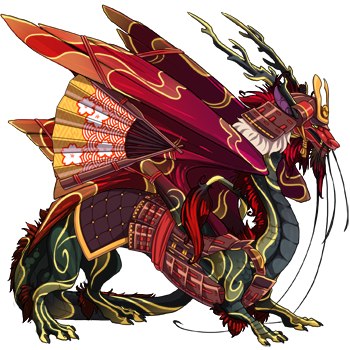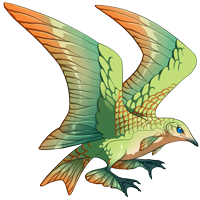

Onmyodo
(#24661099)
Level 1 Imperial
Click or tap to view this dragon in Predict Morphology.
Energy: 0/50

Expand the dragon details section.
Collapse the dragon details section.
Personal Style
Apparel



Skin
Scene
Measurements
Length
19.76 m
Wingspan
14.69 m
Weight
7731.64 kg
Genetics
Obsidian
Iridescent
Iridescent
Garnet
Shimmer
Shimmer
Banana
Smoke
Smoke
Hatchday
Breed
Eye Type
Level 1 Imperial
EXP: 0 / 245


STR
6
AGI
6
DEF
6
QCK
5
INT
8
VIT
8
MND
6
Biography
WORK IN PROGRESS
RP OUTLINE
CLAN TITLE SCIENCE!/ONMYODO/ESOTERIC COSMOLOGIST/ASTRONOMER/DIVINER/FORTUNE-TELLER/SEER/
NAME MEANING
Onmyōdō (陰陽道?, also In'yōdō, lit. ‘The Way of Yin and Yang’) is a traditional Japanese esoteric cosmology, a mixture of natural science and occultism. It is based on the Chinese philosophies of Wu Xing (five elements) and Yin and yang, introduced into Japan at the beginning of the 6th century. It was accepted as a practical system of divination. These practices were influenced further by Taoism, Buddhism and Shintoism, and evolved into the system of onmyōdō around the late 7th century. Onmyōdō was under the control of the imperial government, and later its courtiers, the Tsuchimikado family until the middle of the 19th century, at which point it became prohibited as superstition.
MATES (still looking)
LORE
In the 5th and 6th centuries, the principles of yin-yang and the Five Elements were transmitted to Japan from China along with Buddhism and Confucianism. Yin-yang and the Five Elements, as well as the divisions of learning to which they were linked – astronomy, calendar-making, the reckoning of time, divination, and studies based on observation of nature – were amalgamated into fortune telling. This process of judging auspicious or harmful signs present in the natural world was accepted into Japanese society as a technique for predicting good or bad fortune in the human world. Such techniques were known mostly by Buddhist monks from mainland Asia who were knowledgeable in reading and writing Chinese. Over time demand from members of the imperial court who believed that onmyōdō divination would be helpful in decision-making made it necessary for the laity to perform the art, and onmyōji began to appear around the middle of the 7th century.
With the implementation of the ritsuryo system law codes in the 7th and 8th centuries, yin-yang techniques were put under the jurisdiction of the Bureau of Onmyō (陰陽寮 Onmyō-ryō?) in the Nakatsukasa-shō of the Imperial bureaucracy. The Bureau of Onmyō was responsible for overseeing the divinations of Onmyōdō, astrological observations, and the creation of calendars. Also, by law the Buddhist clergy was forbidden to practice astrology and fortune-telling; hence, government-controlled onmyōji came to monopolize the practice.
From the Heian period onward, as the ritsuryo system relaxed and the Fujiwara family rose to power, the society of the Imperial court took on a more formal shape, and adherence to rituals to placate the souls of the dead (御霊信仰 Goryō Shinkō?) to combat the creation of vengeful ghosts (怨霊 onryō?) burgeoned. Because onmyōji displayed methods that were believed to avert disasters with their skills of divination and magic, the practice afforded onmyōji influence over the personal lives of the Emperor and the nobility of the court. Consequently, popular awareness of onmyōdō gradually spread from court society to Japanese society as a whole, strengthening its development into a characteristically Japanese art.
Onmyōdō merged with other beliefs and occultism, and evolved from imported Chinese thought into a syncretism found only in Japan. Japanese onmyōdō took in elements from Taoism (道教?), which was transmitted to Japan at the same time as onmyōdō, including magical elements such as katatagae, monoimi, henbai, and ceremonies to Taoistic gods such as the Taizan Fukunsai. Elements of feng shui and the medical art of jukondō were incorporated as well, and as onmyōdō and Japanese Shinto mutually influenced each other, onmyōdō grew more distinctive. From the end of the 8th century onward, it was influenced by the magical elements of esoteric Buddhism and the Indian-derived astrology (Sukuyōdō) that were transmitted with it.
During the Heian period the nobility organized their lives around practices recommended by onmyōji. The practice of "lucky and unlucky directions" provides an example. Depending on the season, time of day, and other circumstances, a particular direction might be bad luck for an individual. If one's house was located in that direction, such an individual was advised not to go back directly to his house but had to "change direction" (katatagae), by going in a different direction and lodging there. Such a person would not dare to go in the forbidden direction, but stayed where they were, even if that resulted in absence from the court, or passing up invitations from influential people.
In the 10th century Kamo no Tadayuki and his son Kamo no Yasunori made great advancements in onmyōdō, astronomy and calendar science, and from among their students emerged Abe no Seimei, who displayed superior skills in the divining arts of onmyōdō, by which he gained an uncommon amount of trust from the court society. Tadayuki and Yasunori passed on their skills in astronomy to Seimei while their advances in calendar-making went to Yasunori's son. From the end of the Heian period into the Middle Ages, astronomy and calendar science were completely subsumed into onmyōdō, and the Abe and Kamo families came to dominate the art.
Bought from Auction House on June 18, 2016. (no name/lore)
RP OUTLINE
CLAN TITLE SCIENCE!/ONMYODO/ESOTERIC COSMOLOGIST/ASTRONOMER/DIVINER/FORTUNE-TELLER/SEER/
NAME MEANING
Onmyōdō (陰陽道?, also In'yōdō, lit. ‘The Way of Yin and Yang’) is a traditional Japanese esoteric cosmology, a mixture of natural science and occultism. It is based on the Chinese philosophies of Wu Xing (five elements) and Yin and yang, introduced into Japan at the beginning of the 6th century. It was accepted as a practical system of divination. These practices were influenced further by Taoism, Buddhism and Shintoism, and evolved into the system of onmyōdō around the late 7th century. Onmyōdō was under the control of the imperial government, and later its courtiers, the Tsuchimikado family until the middle of the 19th century, at which point it became prohibited as superstition.
MATES (still looking)
LORE
In the 5th and 6th centuries, the principles of yin-yang and the Five Elements were transmitted to Japan from China along with Buddhism and Confucianism. Yin-yang and the Five Elements, as well as the divisions of learning to which they were linked – astronomy, calendar-making, the reckoning of time, divination, and studies based on observation of nature – were amalgamated into fortune telling. This process of judging auspicious or harmful signs present in the natural world was accepted into Japanese society as a technique for predicting good or bad fortune in the human world. Such techniques were known mostly by Buddhist monks from mainland Asia who were knowledgeable in reading and writing Chinese. Over time demand from members of the imperial court who believed that onmyōdō divination would be helpful in decision-making made it necessary for the laity to perform the art, and onmyōji began to appear around the middle of the 7th century.
With the implementation of the ritsuryo system law codes in the 7th and 8th centuries, yin-yang techniques were put under the jurisdiction of the Bureau of Onmyō (陰陽寮 Onmyō-ryō?) in the Nakatsukasa-shō of the Imperial bureaucracy. The Bureau of Onmyō was responsible for overseeing the divinations of Onmyōdō, astrological observations, and the creation of calendars. Also, by law the Buddhist clergy was forbidden to practice astrology and fortune-telling; hence, government-controlled onmyōji came to monopolize the practice.
From the Heian period onward, as the ritsuryo system relaxed and the Fujiwara family rose to power, the society of the Imperial court took on a more formal shape, and adherence to rituals to placate the souls of the dead (御霊信仰 Goryō Shinkō?) to combat the creation of vengeful ghosts (怨霊 onryō?) burgeoned. Because onmyōji displayed methods that were believed to avert disasters with their skills of divination and magic, the practice afforded onmyōji influence over the personal lives of the Emperor and the nobility of the court. Consequently, popular awareness of onmyōdō gradually spread from court society to Japanese society as a whole, strengthening its development into a characteristically Japanese art.
Onmyōdō merged with other beliefs and occultism, and evolved from imported Chinese thought into a syncretism found only in Japan. Japanese onmyōdō took in elements from Taoism (道教?), which was transmitted to Japan at the same time as onmyōdō, including magical elements such as katatagae, monoimi, henbai, and ceremonies to Taoistic gods such as the Taizan Fukunsai. Elements of feng shui and the medical art of jukondō were incorporated as well, and as onmyōdō and Japanese Shinto mutually influenced each other, onmyōdō grew more distinctive. From the end of the 8th century onward, it was influenced by the magical elements of esoteric Buddhism and the Indian-derived astrology (Sukuyōdō) that were transmitted with it.
During the Heian period the nobility organized their lives around practices recommended by onmyōji. The practice of "lucky and unlucky directions" provides an example. Depending on the season, time of day, and other circumstances, a particular direction might be bad luck for an individual. If one's house was located in that direction, such an individual was advised not to go back directly to his house but had to "change direction" (katatagae), by going in a different direction and lodging there. Such a person would not dare to go in the forbidden direction, but stayed where they were, even if that resulted in absence from the court, or passing up invitations from influential people.
In the 10th century Kamo no Tadayuki and his son Kamo no Yasunori made great advancements in onmyōdō, astronomy and calendar science, and from among their students emerged Abe no Seimei, who displayed superior skills in the divining arts of onmyōdō, by which he gained an uncommon amount of trust from the court society. Tadayuki and Yasunori passed on their skills in astronomy to Seimei while their advances in calendar-making went to Yasunori's son. From the end of the Heian period into the Middle Ages, astronomy and calendar science were completely subsumed into onmyōdō, and the Abe and Kamo families came to dominate the art.
Bought from Auction House on June 18, 2016. (no name/lore)
Click or tap a food type to individually feed this dragon only. The other dragons in your lair will not have their energy replenished.
Feed this dragon Insects.
Meat stocks are currently depleted.
Seafood stocks are currently depleted.
Plant stocks are currently depleted.
Exalting Onmyodo to the service of the Gladekeeper will remove them from your lair forever. They will leave behind a small sum of riches that they have accumulated. This action is irreversible.
Do you wish to continue?
- Names must be longer than 2 characters.
- Names must be no longer than 16 characters.
- Names can only contain letters.
- Names must be no longer than 16 characters.
- Names can only contain letters.










